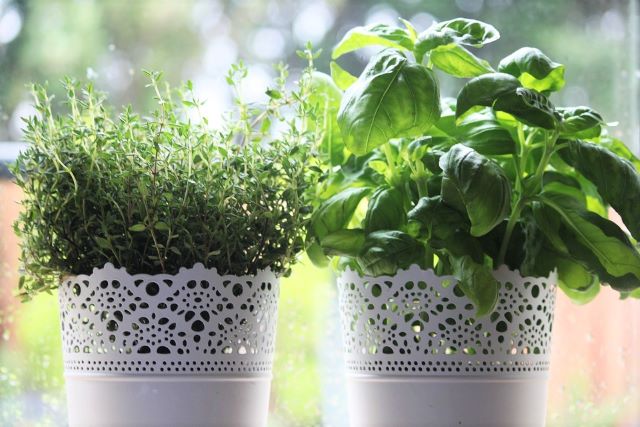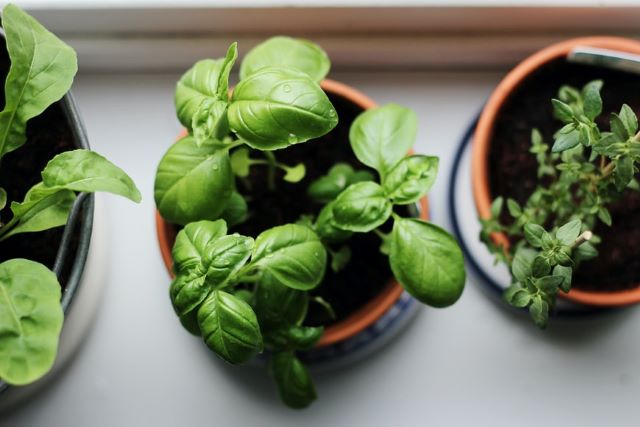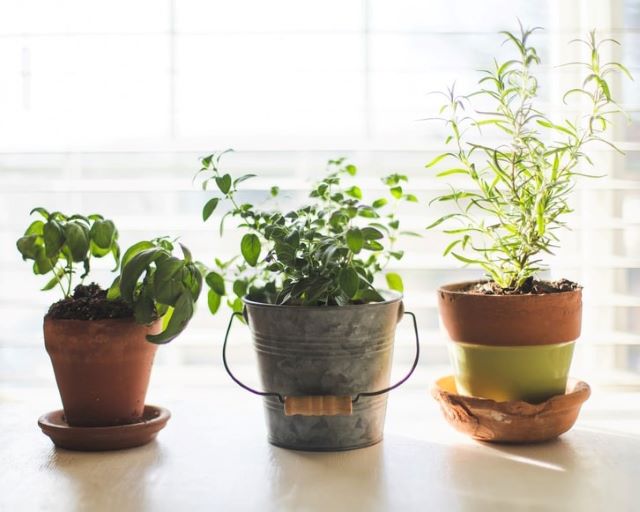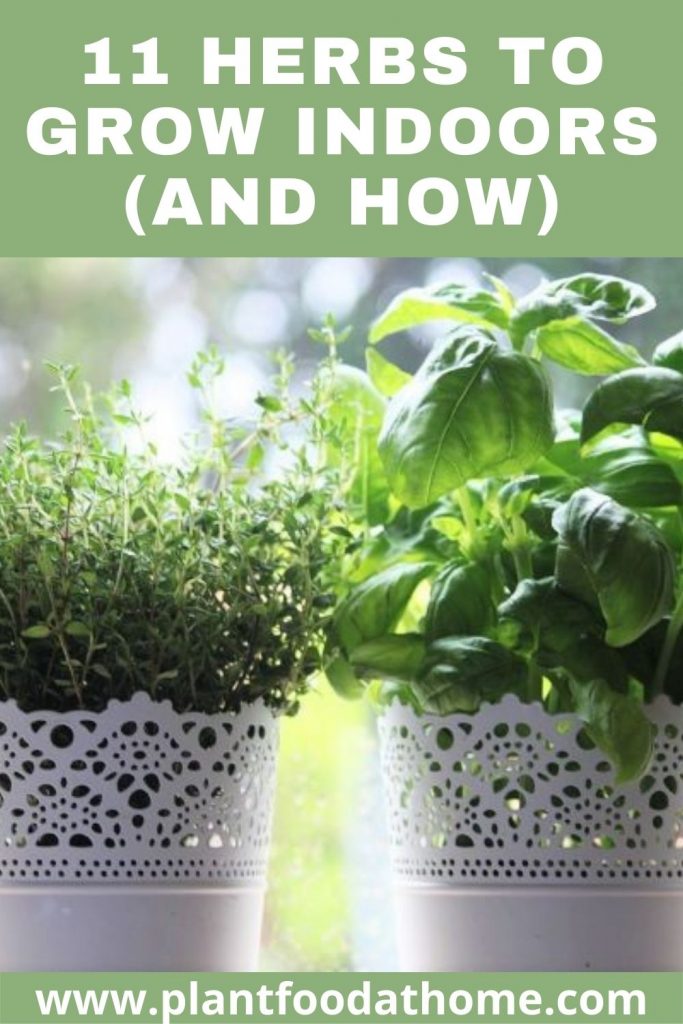There are many benefits to growing herbs indoors. You don’t have to worry about outside temperatures, so you can grow plants no matter where you live. And, you can sometimes keep them producing for longer indoors than out. So what are the best herbs for growing indoors? And how do you care for indoor herbs? Do you need any special supplies? We’ll answer all of those questions and more in this article.

Table of Contents
The Best Herbs To Grow Indoors
1. Basil
Basil is a classic indoor herb, and is currently the centerpiece of my indoor herb garden. Its delicious taste and easy growth make it perfect for those who want to grow herbs they can cook with.
It falls into the category of herbs that like to remain damp, but not waterlogged, so don’t let the soil dry out in between waterings.
Some varieties of basil are perennial herbs, but most are grown as annuals. Basils growth will slow down as it matures and the stems become woodier.
Basil grows upright, typically reaching 1 to 2 feet in height. It doesn’t tend to get very wide, not spreading out more than 1 foot. It needs roughly a 10-inch deep pot to grow well.
2. Thyme
This is yet another fantastic indoor herb. It falls into the dry category, so let the top inch of soil dry out in between waterings. It is a perennial that can keep growing year-round with proper maintenance.
Thyme doesn’t tend to get very tall, only about 6 to 12 inches. However, it is a creeping plant, so it spreads sideways, sometimes very quickly. I’ve found that shallow, wide (or long) pots work best for thyme. It only needs to be about 8 to 10 inches deep, but should have more room to spread sideways.
Bonus: Lemon thyme. One of my personal favorites, this variety of thyme tastes of lemon, even though it has no citrons in it. It grows very similar to standard thyme, but does tend to grow even faster. It has the same needs as its more woody cousin.
3. Sage
Sage’s earthy flavor and strong stems make it a staple of indoor gardening and cooking. For water, it falls into the damp category. It is a perennial and, with proper care, can keep growing all year.
It is a tall plant, reaching between 1 and 3 feet in height. It takes up about 18 inches of horizontal space, as it grows into a healthy plant. Sage needs deep pots, with 12-18 inches of good soil.
Bonus: Pineapple sage. This plant is a tropical variety that combines the earthiness of sage with a pineapple flavor, again without actual citrons. It grows much larger than standard sage (3 to 4 feet tall, 24 inches wide), and tends to stop growing as much after it reaches maturity. Most importantly, it has very deep roots, and needs at least a 24-inch deep pot. I had one that broke through the bottom of an 18-inch pot!
4. Mint
There are so many varieties of mint that it’s perfect for nearly any taste. It’s a perennial that can grow year-round, and grows very quickly. It also spreads voraciously, but in pots it is usually easy to control.
Mint likes to stay consistently damp. It grows 1-2 feet tall, and 12-18 inches wide. It needs a pot that is at least 10-12 inches deep to thrive.
5. Oregano
Whether as a pizza topping or chicken seasoning, oregano is a delicious addition to any garden. It prefers drier soil. Even though it’s a perennial, its growth may slow down after it matures and turns woodier.
Oregano gets about 2 feet tall, with a 12-18 inch spread. It needs a 10-12 inch deep pot.
6. Rosemary
This herb is a larger, woody herb that is used in many recipes. It reaches 3 to 5 feet in height, although it can be pruned to be smaller. It needs at least a 12-inch deep pot.
Rosemary prefers to dry out slightly in between waterings. Its growth may slow as it matures, but constant pruning will help it produce more and grow larger.
7. Parsley
Parsley’s fresh, crisp green leaves are a great addition to any dish. It likes soil that is moist most of the time. It’s easy to keep growing year-round, and doesn’t take up too much space.
It has a max height of around 1 to 1.5 feet. It only needs an 8-12 inch pot. As a biennial herb, parsley grows for around two years. In its second year, it flowers and dies off.
8. Lavender
Lavender is known for its fragrant purple flowers. As such, it tends to be grown in seasons, allowing it to flower, harvest, and then reset. Growing indoors, though, you might be able to have multiple harvests in one year.
It prefers to remain in slightly drier soil. It gets between 1 and 3 feet tall, with a lot of long stalks to bear flowers. It needs a pot that’s at least 12 inches deep.
9. Bay Laurel
This is another herb that is a perennial but tends to slow down on growth once it matures. Bay laurel is actually a type of shrub, and as such can get very big. However, growing indoors it’s easy to keep it between 2 and 4 feet tall through pruning.
It needs at least 12-24 inches of soil to grow in. It prefers to dry out slightly between waterings.
10. Chives
Chives are a great plant for any indoor herb garden. They tend to be harvested once they’re mature, but will grow back after harvesting, so you can keep them going all year.
They like moist soil, and need 8-10 inch deep pots. They only reach about 1 foot in height, so they don’t take up too much space.
11. Ginger
While ginger might not be an herb, it’s a worthy mention for edible plants to grow indoors. It is quite easy to grow, and can produce all year long. It prefers moist soil.
Ginger grows through rhizomes beneath the soil, while also having stalks above the soil. These stalks can get 2 to 3 feet tall, and the plants need at least 12 to 18 inch deep pots. As with thyme, wide or long pots can be good, because they give the plants room to expand sideways.
Indoor Herbs Grow Guide

Many herbs have very similar growing needs, so you can follow the same grow guide for all of them, with some exceptions.
First, you have to think about how you’re starting your plants. Most herbs can be grown from seeds without much trouble, but this will take more time and effort. You can also purchase young or already-established plants from a nursery or other garden supply store.
Lastly, some herbs can be grown from cuttings, or even just separating an existing plant. Thyme in particular is great for separation: if it spreads along the ground, you can wait until it’s big enough and then separate the plant in two, letting each half grow even more.
However you choose to start your herbs, they will have the same general needs once they’ve started to grow.
Lighting Requirements for Growing Herbs Indoors

Lighting is very important. Herbs need at least 6 hours of direct sunlight every day for survival but will thrive with more, sometimes up to 12 or 14 hours (although some of this light might be indirect, and that’s ok).
South-facing windows are typically the best for herbs, because they get the most sunlight. Other windows will work, as long as they get at least 6 hours of direct light. And if you don’t have sunny windows, or not enough window space, you can always purchase grow lights— which we’ll talk about more later.
Watering Indoor Herbs
Water is also important for herbs. They like to be watered significantly, but not to sit in excess water. Generally, herbs fall into two categories: those that like to have consistently moist soil, and those that like to dry out a little bit between waterings. For those that like to dry out a bit, only the top inch or so of soil should dry in-between waterings.
Because root rot can be a problem for potted plants, you need to make sure your pots have good drainage. Give them trays, saucers, or something else to drain into. And if you’re worried about excess water in the soil, putting some pebbles in the bottom of the pot can help.
Pots and Containers for Indoor Herbs
When it comes to pots and containers for growing indoor herbs, you have a few options. Clay pots are better for drainage, but they tend to dry out quickly and aren’t as suited to growing herbs. Plastic or glazed pots that still have good drainage will usually work better.
Temperature and Climate for Indoor Herb Growing
Luckily, the temperature for growing herbs indoors is easy: room temperature! As long as you have a fairly standard room temperature between 65 and 75 F (18-24 C), your herbs will love it. And if it dips a little above or below that, they will be ok.
Since your plants are inside, you also have to think about humidity. Most herbs don’t like to have their leaves wet, and this can lead to disease. However, they don’t like dry air. If the air in your home is drier, consider getting a humidifier for the room. You can also fill a small tray with pebbles, add water, and place it near your plants: as the water evaporates, it will create more humidity in the air.
Grow Lights: why and how to use them, plus options
As we mentioned before, grow lights aren’t necessarily required to grow herbs indoors. However, if you want more hours of direct light, or don’t have enough good window space, they can be very helpful for your herb plants.
Firstly, how long should you have your grow lights on? In general, 12-14 hours of light a day leads to the best herb plant growth. If you want your plants to grow more slowly, or they’ve already slowed down because of age, you could consider doing only 8-10 hours of lighting a day.
Also, if you want your herbs to follow their natural growing seasons, then try to have the lights follow sunlight patterns for the time. However, this means your herbs might not produce as much as they can.
It’s also important to keep your lights far enough away from the herbs. In general, you want at least 6 inches (15 cm) of space between the lights and plants, to prevent the leaves from getting too hot or “sunburnt”. They will also work up to 12-18 inches (30-45cm) away and can depend on the light you use as well as the size of the plant.
Lastly, please don’t forget to turn your lights off. Not only can leaving them on all the time cause electrical hazards, but it’s bad for the plants. Plants also grow at night, when they can use the energy they made during the day. So your plants need time with the lights off, so they can continue to grow.
Sometimes, remembering to turn the lights on and off at specific times can be difficult. A timer can be incredibly helpful for this. I use this timer, which includes both timed outlets and always-on ones, and has a lot of programming options.
The Best Grow Lights for Indoor Herbs
Now that you know how to use grow lights, let’s look at some of the best ones you can get for your herb plants.
- Diboy’s LED Grow Lights: I have experience with these lights, and they’re one of the best options. They’re not too expensive, falling in the middle of the standard price range. They can cover a fairly big area, and since they’re a strip, it’s easy to get the same amount of light and distance on all plants. Plus, the blend of different wavelengths is great.
- GooingTop Grow Light with Adjustable Stand: If you’re willing to spend a bit more money, these lights are a great option. They have adjustable height, and four separate strips of light. Plus, they have a built-in timer and options for different wavelengths, so you can adapt them to meet your plants’ needs.
- Fauna LED Grow Lights: If you like the last option but want something a little more affordable, these lights are for you. They also have four strips and a built-in timer, but aren’t quite as large and don’t have as many customization options. Still, on a budget, they’ll provide everything your plants need.
Conclusion
So there you have it! Everything you need to know to grow herbs indoors, as well as what the best herbs to grow are. Hopefully, you’ll have a delicious edible indoor garden in no time.
- Best Indoor Herb Garden Kit
- Watering Cans for Gardening Outdoors and Indoors
- How to Start Vegetable Seedlings Under Grow Lights
- Spots on Oregano Leaves? Causes and Solutions
- Where to Buy Seeds Online: Herb, Vegetable and Heirloom Seeds
- Sage Plant Dying? Common Causes and Solutions!



